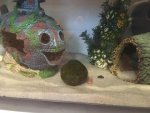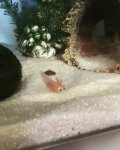Axolotls are not very active animals, so activity level is not a very good indicator of health. A healthy axolotl has fluffy or feathery-looking gills and a smooth, even tail. When stressed by current or high temperatures, the gills tend to turn forward, the tip of the tail may bend and the axolotl will likely refuse food or be unable to chew it/keep it in. In poor water conditions, the gills tend to deteriorate, the tail tends to erode, and the skin may get irritated red patches or cottony white patches. Those are the things you want to look for.
Regarding food, it's normal for your axolotl to go off his food for some time after a binge. He needs time to digest all of those bloodworms! Adult axolotls do well on a diet of one nightcrawler every other day. You'll know your axolotl has had enough to eat when his belly gets roughly as large as its head. At this age, eating once a day is fine. As they get older, they get fussier and that's usually a sign that you can start spacing meals out a little more.
As others have mentioned, if your axie is still this small after 3 months, he must be the runt of the litter. It doesn't necessarily mean something is wrong with him genetically -- maybe his siblings were just better at catching the food, or maybe he's had to devote energy to regrowing limbs at some point. Without competition, he may start to grow really fast. Give it a month or so, and if he hasn't grown much, we can start to look at possible causes.
Finally, keeping him on sand is not a great idea at this size -- he'll definitely be swallowing some of it, so you want to make sure it doesn't cause a blockage. Removing the sand from your aquarium would be a nightmare, so I would recommend keeping the little guy in a plastic tub for a couple weeks, just to give him a chance to get bigger before moving him back to the tank again. You can use one of the "omni" clear plastic totes from the dollar store and float it in the aquarium if you like.


